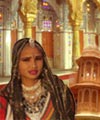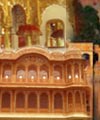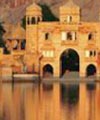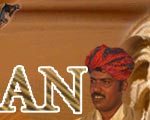| Encyclopedia of Tours and Travel to Rajasthan, featuring information on Fairs & Festivals, Wildlife, Excursion, Adventure and Weather of Rajasthan. |
 |
 |
 |
 |
 |
 |
 |
||
|
Chittaurgarh
110 km from Udaipur and 300 km from Jaipur was founded by Bappa Rawal in 8th century. Known for the massive fort 3 mile long and 495 feet high. Mirabai, 16th century poet and saint was from here. Also known fro Vijaystambha, Kirtistambha (Tower of Victory), and Rani Padmini. Alauddin Khilji was the first to sack Chittaur in 1303 A.D. overpowered by a passionate desire to possess the regal beauty, queen Padmini. Legend has it, that he saw her face in the reflection of a mirror and was struck by her mesmerising beauty. But the noble queen preferred death to dishonour and committed ‘Jauhar’. In 1533 A.D., during the rule of Bikramjeet, came the second attack from Bahadur Shah, the Sultan of Gujarat. Once again Jauhar was led by Rani Karanavati, a Bundi princess. Her infant son, Udai Singh was smuggled out of Chittaur to Bundi who survived to inherit the throne of the citadel. He learnt from his traumatic childhood that discretion is preferred to valour. So in, 1567 A.D. when the Mughal Emperor invaded Chittaur, Udai Singh fled to establish a new Capital, Udaipur-a beautiful lake city, leaving behind Chittaur to be defended by two 16 year old heroes, Jaimal of Bednore and Patta of Kelwa. These young men displayed true Rajput chivalry and died after ‘Jauhar’ was performed. Immediately thereafter Akbar razed the fort to a rubble. Chittaur was never inhabited again but it always asserted the heroic spirit of Rajput warriors. Culture The Fort Vijay Stambh (Victory Tower) Kirti Stambh (Tower of Fame) Rana Kumbha’s Palace Meerabai Temple This temple was built during the reign of Maharana Kumbha and later given to Mira Bai when she needed a place to worship Lord Krishna, the main subject of her poems. It is a good example of Rajput architecture, designed in North Indian style on a raised plinth, with a conical roof over the inner sanctum. The dome is carved in a circle of five human bodies with one head that symbolises belief that the people of the four castes (Varnas), as well as the fifth caste Harijans, can all realise God. Within the sanctum are paintings of Lord Krishna and of Mira Bai in devotion (bhakti) to the god. The open colonnade around the sanctum has four small pavilions. A small chhatri stands in the temple's forecourt, said to have been built in memory of Mira's saintly guru, Rai Das (SwamiRavidas) of Varanasi, a Harijan. The saint's footprints are marked on the floor of this small shrine. Padmini’s Palace Kumbha Shyam Temple Situated on the on the eastern side of Chittorgarh, the Kumbha Shyam Temple is dedicated to Varah, the Boar incarnation of Vishnu. This temple was erected by Maharana Kumbha on a base laid in the 9th century AD. A large image of Garuda, the mythical bird, is in front of the temple, under a canopy supported by pillars. A fine example of Indo-Aryan style of temple architecture, this temple has a soaring Shikra, a mandap (porch or pillared hall) covered with a stepped, pyramid-shaped roof, and a pardakshina (colonnaded walkway) around the sanctum. There is a small pavilion at each of the four corners. The sanctum has beautiful idols depicting Lord Vishnu in different moods, and carvings of life in the 15th century. It is believed that, originally, this temple was a Vishnu Varah temple but was destroyed during Mughal attacks.
Kalika Mata Temple Across form Padmini place is the Kalika Mata Temple, an 8th-century temple originally dedicated to Surya or the Sun God but later converted to a temple to the goddess Kali. The temple architecture is of the early Paramara (Pratihara) period.It was built upon a large raised plinth, and features beautiful carvings and sculptures on the exterior and the mandap (pillared hall), also on the pillars, ceiling and gates of the shrine. Unfortunately, today it has lost its spire and also reveals vestiges of considerable repairs, but its beauty remains an inspiration, but not for Sultan Ala-ud-din khilji. After the first sack of Chittor in 1303, he and his Muslims destroyed the temple. Once a year a fair takes place here in which thousands of visitors from distant places participate. Of similar style are the ruins of a small temple and a colonnade near the Mahasati, the fort's royal cremation ground. Government Museum Jaimal and Patta Palaces Nagari (20 km) Seven Kilometers from Bassi, on the Chittaurgarh road, is Nagri, one of the oldest towns in Rajasthan. Hindu and Budhdhist remains from the Mauryan to Gupta periods have been found here. Many old copper coins and sculptures discovered here are now is museums in Chitaurgarh and Udaipur. Bassi Village (25 km) Sanwariyaji Temple (40 km) Matri Kundia Temple Bijaipur (40 km) Sita Mata Sanctuary,Dhariyavad The common fauna that can be sighted here includes leopard , hyena, jungle fox,porcupine,sambhar,wild boar, four horned antelope, nilgai and flying squirrel. Deogarh (125 km) Menal (90 km) Shopping Know for its wooden painted toys made in the surrounding villages, and thewa gold jewellery in its own distictive style. Also Akola printed fabrics and leather juttees made in Gangrar. Getting There By Air Udaipur is the nearest airport. Daily flight form Delhi, Mumbai, Jaipur and Lucknow are available to Udaipur. By Bus By Train Getting around
|
||||||||||
|
||||||||||
|
||||||||||
|---|---|---|---|---|---|---|---|---|---|---|